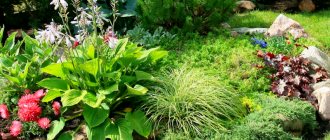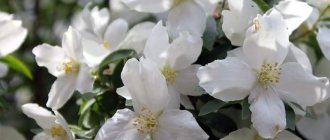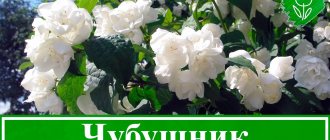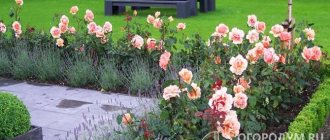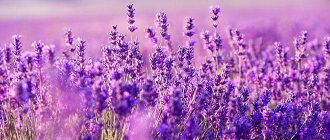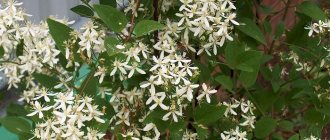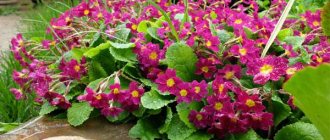Author: Elena N. https://floristics.info/ru/index.php?option=com_contact&view=contact&id=19 Category: Garden plants Published: January 13, 2019Last edits: November 18, 2021
- Growing conditions
- Wintering
- French lavender (Lavandula stoechas)
- Medicinal properties
plant (lat. Lavandula) belongs to the genus of the Lamiaceae family, which includes about 30 species. The lavender flower grows naturally in the Canary Islands, East and North Africa, Australia, Arabia, India and southern Europe. There are only two types of lavender grown in cultivation around the world - broadleaf lavender (French) and angustifolia lavender, or medicinal (English). The name of the plant comes from the Latin lava, which means “to wash” and indicates the purpose of lavender in the Ancient world - the Romans and Greeks used the plant for washing and washing. Today, lavender flowers grow not only in private gardens, but are also grown on an industrial scale as a valuable essential oil crop.
Planting and caring for lavender
- Planting: sowing seeds in the ground - in October, sowing seeds for seedlings - in February or March, planting seedlings in the ground - in late May or early June.
- Flowering: in the second half of summer.
- Lighting: bright sunlight.
- Soil: dry, drained, sandy or loamy, pH 6.5-7.5.
- Watering: regular and plentiful, frequent during drought.
- Fertilizing: twice a season: in the spring – with a mineral complex with a high nitrogen component, in the fall – with potassium-phosphorus fertilizers.
- Hilling: in spring and autumn you need to hill up old bushes high.
- Pruning: after flowering, cut off the inflorescences, and shorten the branches in the fall. When the bush reaches ten years of age, the bush is rejuvenated by cutting off all branches at a height of 5 cm from the ground.
- Reproduction: by seeds and vegetatively - layering, cuttings and dividing the bush.
- Pests: leafhoppers (slobbering pennies), rainbow beetles and aphids.
- Diseases: gray rot.
Read more about growing lavender below.
Taking steps to revive the plant
If suddenly the young lavender does not bloom for the first time after planting, the buds do not fill, you should carefully examine the bush:
If there are insect pests or diseases, they take measures - spray the plant, collect the larvae by hand.- You should also carefully weed the soil around the bush and loosen it - the roots need access to air.
- To produce buds and during the flowering period, it is necessary to apply mineral fertilizers.
- Regular watering is very important for a young plant.
- If the bush was planted in a shaded area, it should be urgently transplanted to where there is maximum access to sunlight.
An adult plant can also upset its owner by the lack of budding. This is possible due to the fact that the large roots of lavender are located in swampy soil, a lowland, which is detrimental to the plant.
At first the plant will refuse to bloom, then the branches will wither and the lavender will die. The crop should be urgently transplanted to an elevated, sunny place. There may also be reasons for the lack of flowering, similar to those listed above, the measures taken are the same.
Botanical description
Lavender is a perennial evergreen shrub with a woody fibrous root going 2 meters deep, numerous woody shoots in the lower part reaching a height of 60 cm, opposite sessile linear silvery-greenish leaves with soft pubescence and fragrant blue or blue-lilac flowers collected into interrupted spike-shaped inflorescences, 6-10 pieces in whorls. Inflorescences form on the tops of leafless stems. Lavender begins to bloom in the second half of summer. Lavender is an excellent honey plant. When properly stored, lavender seeds can remain viable for many years.
Lavender is a relative of such crops as hyssop, basil, mint, lemon balm, motherwort, oregano, sage and rosemary. We will tell you how to grow lavender from seeds, what are the conditions for growing lavender in open ground, how lavender is planted and cared for in open ground, how to propagate lavender, how lavender winters in Moscow and we will give a lot of interesting and useful information about this garden plant.
6.Note, interesting facts
The plant has phytoncidal properties and is capable of killing airborne pathogens. The aroma of lavender helps relieve nervous tension and fatigue. Interestingly, 80% of lavender is concentrated in the province of Provence, located in France - the flower is the hallmark of this area. When grown in the garden, lavender attracts many beneficial insects with its blooms and is an excellent honey plant.
Hydroponics.
Planting lavender in open ground
When to plant
Lavender is planted in the ground either with seeds in October or seedlings at the end of May. In order to grow lavender from seeds, seed material should be purchased at the beginning of winter or autumn, since before sowing in the ground, the seeds are stratified for 2 months at a temperature of 5 ºC to increase germination. Typically, seeds mixed with wet sand are stratified in the vegetable drawer of the refrigerator. Sow lavender seeds for seedlings in February or March.
- Growing alyssum seedlings
Seedling care
While the seeds are in the refrigerator, prepare a container for sowing and a substrate for the seeds by thoroughly mixing two parts of humus with one part of coarse river sand. Sift the mixture - lavender seeds are very small, so the substrate should not contain any lumps - and bake it in the oven at a temperature of 110-130 ºC or pour it with a bright pink solution of potassium permanganate. Place the treated soil mixture in a growing container with drainage holes on a drainage layer.
In the photo: Lavender blooming in the field
At the very end of winter or at the beginning of spring, sow lavender seeds on the surface of the substrate in a container, sprinkle them with a 3 mm thick layer of sand, spray them with warm water from a spray bottle, cover them with glass or plastic wrap to create a greenhouse effect and place them in a bright, warm place. From time to time, crops need to be ventilated by lifting the cover. Seeds are germinated at a temperature of 15-22 ºC.
How to grow lupine in the garden - a beautiful flower and green manure
How to care for lavender during the seedling period? As soon as the seedlings appear, you will have to provide them with additional lighting so that the lavender seedlings do not stretch out. Remove the covering every day for a while so that the seedlings get used to the temperature in the room, and as soon as they adapt to it, the film can be removed completely and the seedlings can be planted so that the distance between them is at least 5 cm.
How to plant in the ground
At the end of May, it is time to plant lavender in the garden. Most often, lavender is used to decorate alpine slides, use it as a border, or plant it on both sides of paths. Lavender grows well in bright sun. Do not plant it in wetlands or areas with high groundwater levels, as lavender is very sensitive to excess moisture. The plant prefers dry, sandy soil, but also grows well on loamy soils with good drainage.
The optimal acidity level for the plant is 6.5-7.5 pH. Ground limestone will have to be added to acidic soil. Before planting lavender, you need to prepare the area: dig up to a depth of at least 20 cm and loosen the soil well, adding peat or compost for digging.
How to plant lavender? Lavender is planted with a distance of 80-90 cm between seedlings, and a distance of 120 cm is maintained between bushes of tall lavender. The depth of the hole should be such that the root system of the seedling can freely fit into it. Before planting, the roots are slightly trimmed, then the lavender bush is placed in the hole and buried, deepening the root collar by 4-6 cm. After planting, the lavender seedlings are watered abundantly.
In the photo: Growing lavender in the garden
Pre-winter sowing
In areas with warm winters, it is better to sow lavender seeds directly into the ground. This is done in October, after they have prepared the soil on the site by adding peat for digging, and if the soil is too wet, then fine gravel or sand is added to it to increase moisture and air permeability. Seeds are sown to a depth of 3-4 cm, slightly compacting the soil surface after sowing. If autumn is dry, water the crops, but not too much, and with the first snow, throw a small snowdrift over the area.
Caring for lavender in the garden
Growing conditions
As soon as the first inflorescences appear on lavender seedlings, it is advisable to remove them so that young plants, without wasting energy on flowering, can grow stronger and grow a powerful root system. The first year lavender grows very slowly in the garden, so it is necessary to fight weeds that can choke the seedlings. How to grow lavender? What kind of care does lavender require in the garden? You will need to water the plant regularly and deeply, and in extreme heat, watering should become frequent. After watering or rain, it is necessary to loosen the soil between the bushes and weed the area, but if you want to save time and effort, mulch the soil between the bushes with peat after planting.
How to grow a rose by saving cuttings from a bouquet
Old bushes should be hilled high in spring and autumn - this measure promotes the formation of new shoots on old branches. In addition to the listed procedures, you will have to trim the lavender and add fertilizing to the soil, giving preference to potassium fertilizers, since manure and nitrogen fertilizers only promote the growth of greenery, but inhibit the flowering of lavender, for which, in fact, it is grown.
In the photo: Lavender field
Trimming
Growing lavender will require you to prune the plant annually. As soon as flowering ends, cut off the faded inflorescences, and in the fall, shorten the branches, maintaining the shape of the bush.
Do not let the lavender stretch upward too much, because in windy weather its bushes will lie down and lose their decorative effect.
- Foxglove: growing from seeds, types and varieties
When the bush reaches ten years of age, it is advisable to carry out anti-aging pruning, shortening all branches to 5 cm. The same can be done with a young bush if its flowering is not lush.
Reproduction
Lavender propagates, in addition to the seed method, also by dividing the bush, layering and cuttings.
If you already have a lavender bush on your site or you managed to get a one-year-old woody shoot of a plant from someone, you may well get lavender from cuttings. Cut cuttings 8-10 cm long from the shoot, plant them in moist, loose soil, deepening the lower cut by 2-3 cm, and cover with glass jars. You can remove the jars when the cuttings take root.
In order to divide a lavender bush, it needs to be prepared for this. In the fall, after flowering, a large bush is cut at a height of 10 cm and hilled, filling all the space between the shoots with earth. In the spring, hilling is repeated. During the summer, the bush produces abundant growth. In the fall, the bush can be dug up, divided into parts with well-developed roots and shoots, and planted.
To propagate by layering in the spring, several shoots are bent back, placed in grooves 3-4 cm deep, secured in this position, covered with soil and watered. All summer the soil above the cuttings is kept moist, and next spring the rooted shoot is separated from the bush, divided into parts and transplanted to a permanent place.
Pests and diseases
Lavender in open ground is extremely resistant to both diseases and pests, but it is not immune to problems. Sometimes lavender can suffer from leafhopper, or slobbering pennies, and rainbow beetle, and among diseases, lavender can be affected by gray rot.
In the photo: How lavender blooms
Cicadas and rainbow beetles will have to be collected by hand, after which you should definitely change the layer of mulch in the area. And gray rot, which usually appears in damp, rainy summers or in cases of chronic waterlogging of the soil by too frequent watering, cannot be cured, but the diseased parts of the lavender can be removed and burned so that the infection does not spread to all plants. And, of course, you need to reconsider the lavender watering regime.
Lavender in Moscow and Moscow region
With full confidence in success in the conditions of Moscow and the Moscow region, you can only grow English lavender - narrow-leaved, or medicinal. Planting and caring for lavender in the middle zone is carried out according to the same principles and in almost the same time frame as in warmer areas. Seeds are sown in the ground when surface frosts have passed - in the second half of May, and seedlings are planted in early June. Sowing seeds before winter is risky - they may freeze.
Reproduction methods
Lavender can be grown from seeds, and also propagated by layering, dividing the bush and cuttings. How to grow it from seeds is described in great detail above.
Propagation by cuttings
This propagation method is suitable for those who already have lavender on their site or have the opportunity to get its lignified annual shoot. The stem is cut into lengths from 80 to 100 mm. The resulting cuttings are planted for rooting in a loose, moistened substrate, while their lower cut is buried by approximately 20–30 mm. They are covered with transparent glass jars on top. It will be possible to remove the shelter only after the roots of the cuttings grow.
Dividing the bush
To propagate the crop, the method of dividing the bush is also used. However, the plant should be prepared for this procedure. Select a mature, overgrown shrub. With the onset of autumn, when it fades, it should be pruned to a height of about 10 centimeters, after which it is hilled high, trying to fill the entire space between the stems with soil. In spring, the plant is hilled again. Throughout the summer, the bush produces abundant growth.
With the onset of autumn, the bush is removed from the ground and divided into several parts with well-developed roots and stems. Next, the divisions are planted in a new place in separate holes.
Reproduction and planting of lavender
Reproduction by layering
To propagate the shrub by layering, in spring you should select several stems, bend them and place them in grooves 30 to 40 mm deep, made in the soil near the plant. Fix the shoots in this position, cover them with soil and water well. During the summer period, make sure that the soil above the layering is always slightly moist. It is possible to separate the cuttings that have given roots from the bush only with the onset of the next spring. Next, the cuttings are dug up and planted in a permanent place.
Caring for lavender after flowering
Wintering
If in your area the temperature in winter can drop below 25 ºC, you need to reliably protect the area with lavender from frost, but do not use fallen leaves as insulation, since the lavender under it may rot in winter. It is best to cover the lavender bushes with spruce branches after autumn pruning.
In the photo: Blooming lavender field
In areas with not so cold winters, angustifolia lavender is not covered.
Why doesn't it bloom?
It may happen that lavender does not bloom at the right time, the reasons may be the following:
- the plant froze during the winter - the root system was damaged and weakened;
- in the spring they did the wrong pruning - they cut the branches too short, affecting the buds, or, on the contrary, they cut off a small number of branches, which is why sunlight does not reach most of the dense bush;
- the plant had little light or it constantly experienced an excess of moisture (in the lowlands) - the planting site was chosen incorrectly;
- the soil composition is acidified, not suitable for crops;
- fertilizing and fertilizing were not applied on time;
- the presence of diseases, pests or unweeded weeds.
Irregular watering can also negatively affect the flowering of lavender bushes, although this plant tolerates drought well.
Types and varieties
So far, only such types of lavender are grown in cultivation as lavender angustifolia (English) and French lavender, also known as broadleaf. But since there are other types of lavender suitable for cultivation, we offer you a description of them. So:
French lavender (Lavandula stoechas)
Or broadleaf lavender (Lavandula latifolia) native to South-West Europe. It is distinguished by its strong aroma and beauty of flowers in different shades of purple, pink, lilac, green, burgundy and white. Flowering in French lavender begins earlier than in other plant species - in April or May - and continues until July, but at the end of summer, broadleaf lavender can bloom again. French lavender is not as cold-hardy as English lavender, so it is grown mainly in warm areas.
The most popular variety of this species is Lavandula stoechas pedunculata, or "butterfly" (Papillon), with flowers of an original shape. The most famous varieties of broadleaf lavender are:
- Yellow Vale is a variety with dark purple flowers, crimson bracts and yellow-green leaves;
- Regal Splendur - a variety with dark purple flowers;
- Rocky Road is a new variety with large lilac-blue flowers that bloom in July;
- Tiara - large blue flowers with cream bracts;
- Helmsdale is a variety with lilac-burgundy flowers.
In the photo: French lavender (Lavandula stoechas)
Hybrid lavender (Lavandula x intermedia)
Or Dutch lavender is a group of highly decorative hybrids between English lavender and other species of the genus. These are large plants with silvery narrow leaves and large oblong flowers on long peduncles that bend under the weight of the flowers. Hybrid lavender begins to bloom in July.
- Carnation Shabo: growing from seeds, planting and care
The most famous varieties of Dutch lavender:
- Alba is a variety with white flowers;
- Arabian Knight - a variety with flowers of dark blue or dark purple color;
- Sawyers - form with light purple flowers;
- Grosso - a variety with large flowers of a lilac-violet hue;
- Richard Gray is a compact bush with dark purple flowers.
In the photo: Hybrid lavender (Lavandula x intermedia)
Toothed lavender (Lavandula dentata)
Comes from the Mediterranean. This is a heat-loving compact plant with soft, rugged leaves of a silvery hue and large, fragrant flowers that open in July. The plant is not cold-resistant. The most popular variety of scalloped lavender is Royal Crown, a plant with purple flowers.
In the photo: Toothed lavender (Lavandula dentata)
Lavender angustifolia (Lavandula angustifolia)
Either English lavender (Lavandula spicata) or lavender officinalis (Lavandula officinalis) comes from Southern Europe. It is a perennial shrub with silver-green leaves and small bluish-lilac flowers that bloom in July or August. This is the most winter-hardy type of lavender. The most famous variety of angustifolia lavender is delphinium lavender, which reaches a height of no more than 30 cm, but has very beautiful silvery foliage. Hidcoat lavender is also widespread and is used mainly for low hedges.
Among the varieties of English lavender, the most popular in culture are:
- Alba - a variety up to 50 cm high with white inflorescences;
- Rosea is a bush up to 40 cm high with lilac-pink flowers;
- Manstead is a bush about 40 cm high with deep blue flowers;
- Hidcoat Giant is a compact plant up to 60 cm high;
- Hidcoat Blue is a compact bush up to 40 cm high with blue-violet inflorescences.
In the photo: Narrow-leaved lavender (Lavandula angustifolia)
Period
There are certain nuances in the flowering period, which depend on the genus and variety of the plant:
- Narrow-leaved lavender often begins to bloom in late June, early July. Flowering continues for two months.
- Broad-leaved - will delight its owner with excellent flowering from April until June-July inclusive. After a short break, the plant can also present a second phase of flowering - from the end of August to October. This is an excellent choice for decorating the interiors of rooms and rooms.
- Serrated or Dutch - from the first days of June to August.
Of course, the duration of flowering also depends on weather conditions - in northern cold regions, flowering may begin later and end earlier, and vice versa.
Properties of lavender - harm and benefit
Medicinal properties
All above-ground parts of lavender contain essential oils, which include linalool, coumarins, ursolic acid, tannins, geraniol and borneol. Lavender oil has many beneficial properties and is widely used in the perfumery, cosmetics and medicine industries. Lavender oil is used to treat burns and bruises.
Lavender is used to treat cerebrovascular diseases, paralysis and convulsions after a stroke, as well as to relieve headaches, dizziness and drowsiness. It has a diuretic effect and relieves toothache. Tea with lavender can relieve stomach spasms and discomfort.
Lavender helps with melancholy, irritability, hysteria and neurasthenia, as well as with influenza, asthma, bronchitis, whooping cough, tuberculosis, enteritis, flatulence, atony of the gastrointestinal tract, worms, rheumatism, cystitis, amenorrhea, hypertension, fever and various rashes.
In the photo: Lavender is a useful medicinal plant
Doctors note the remarkable effect of lavender infusion on the general mental state of a person and on his nervous system as a whole. It relieves stress and reduces the negative impact of adverse factors on a person’s consciousness and mental state, helps restore strength and energy and stimulates mental activity.
Lavender greens are used for medicinal baths, and dry inflorescences are used as a remedy against moths when storing clothes and for scenting rooms and linen.
Contraindications
It is not recommended to use lavender oil during pregnancy, especially in the first months, as lavender stimulates the contraction of the uterine muscles. Do not use oil after an abortion, so as not to provoke bleeding. Lavender is contraindicated while taking medications containing iron or iodine.
Intensive use of oil can cause depression and irritation of the gastrointestinal mucosa.
Lavender-based preparations have a powerful effect and can cause a severe allergic reaction if you are individually intolerant to the plant, so before using them, be sure to consult your doctor.
Application
Lavender is a universal plant that has found its use in many areas of human life. This crop is unique in its purpose, since it has a pleasant smell, useful substances and high decorative value.
At home
The use of lavender for domestic purposes is due not only to its decorative properties, but also to its properties. Lavender flowers emit a pleasant aroma, which allows the plant to be used industrially for the production of air conditioners and flavorings. In addition, lavender is a common ingredient in perfumes, as it is actively used in perfumery.
The flowers of the shrub are used as decorative components of flower arrangements. This crop remains decorative for a long time, which is why flower bouquets are made from it. The smell of the plant repels insects, so flowers are often placed in bedrooms and living rooms not only as a freshener.
Dry lavender petals are also used at home, and they are used to make a kind of perfume that helps repel moths. Lavender is also used in cooking as an additive to meat and fish dishes.
In medicine
Traditional medicine uses lavender flowers and leaves, as well as lavender oil. You can purchase the medicine at any pharmacy, since the medicine is freely available. Despite its availability, you need to know why to use the plant for medicinal purposes. The plant has a calming, strengthening and choleretic effect. Most often, the plant is used for sleep disorders, as well as for vegetative-vascular dystonia.
In pharmacological practice, lavender is prescribed to infants to relieve colic. In adults, the plant is used to treat diseases such as:
- headache;
- dyspeptic symptoms;
- rheumatic pains.
Lavender tea and infusion have an immune-stimulating effect. The plant is prescribed for inflammatory pathologies of the respiratory system - bronchitis, sinusitis, laryngitis, otitis media. Lavender flowers and leaves have an expectorant effect.
In gynecological practice, lavender is prescribed for the treatment of inflammatory and infectious diseases. The plant is also used in traditional medicine as a soothing treatment for burns, wounds and bedsores, as well as snake and scorpion bites.
Lavender essential oil is widely used in aromatherapy and massage. The product is used in cosmetology to improve the condition of skin and hair.
In folk medicine
In folk medicine, the flowers and leaves of the perennial are used as a sedative. In addition, based on the plant, preparations are prepared that help eliminate spasms and remove bile from the body. When treating purulent rashes, lavender oil is used.
Recipes
- For insect bites, lotions with lavender oil and essential oils, which are placed indoors, help to prevent the appearance of pests. Lotions are applied to the bitten area.
- Lavender tea is an excellent sedative that helps relieve tension headaches and insomnia. To prepare it, dried flowers are brewed in a glass of boiling water. To achieve the effect, just add 3 teaspoons of the plant. The mixture is infused for 15 minutes, then filtered and taken 2-3 glasses per day.
- inhalations for the treatment of inflammatory diseases of the respiratory tract - 1 drop of lavender oil is enough for one inhalation. The product is used no more than 2 times a day.
- non-healing wounds and acne, purulent rashes are treated by treating the surface with oil and lotions.
